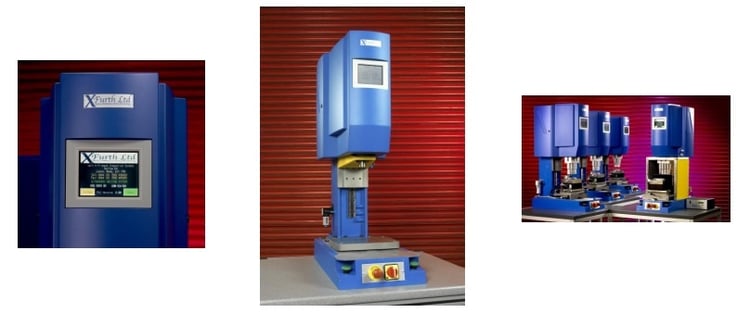
Ultrasonic plastic welding is a straightforward process that can take on many unique forms. Regardless of the specific application, the fundamentals of ultrasonic welding are the same. By using ultra high frequency sound waves, plastic is heated locally via friction, and deformed to meet specifications.
This process is extremely precise, and can be applied to many kinds of plastic. The materials are bonded without adhesives or the application of heat. While there is a very small amount of heat generated by the process, the equipment relies on sound waves, not direct heating, to create the weld.
The advantages that ultrasonic welding can offer you are enormous. By using this process you can achieve a high rate of production, with consistent results. Unlike an adhesive, the bonding mechanism is computer controlled. This allows a high degree of integration into an automated system, with ease of quality control.
Ultrasonic welding equipment is also the most cost effective method of welding. In most cases a standard bench mounted machine in 20 kHz is suitable and in order to weld different jobs the only aspect the needs to be changed is the tooling.
How It Works
1. To begin, two plastic components (sometimes more as it is possible to weld multiple components using multi-impression tooling) are inserted into an anvil or location nest this will hold them in place while they are welded.
2. A sonotrode, or horn is applied to the materials using pneumatic force, and an ultra-high frequency wave is created using an ultrasonic stack. This is usually comprised of three parts, a transducer, a booster and a sonotrode.
3. After the weld is complete, the stack remains on the parts momentarily applying force on the cooling parts, this cooling phase usually only takes 1 second or less.
What It Can Do For You
While the mechanics of an ultrasonic welding system are straightforward, the potential for its use are vast. The application of sound waves is extremely easy to control, so making repeatable welds using this system is an advantage it offers. The entire process is very fast, and for thin plastics it can take less than a second or two, from start to finish.
With the advent of automated production systems, ultrasonic welding offers manufacturers a cost effective way to create strong bonds in a short time. Because it relies on the material to deform, there is no adhesive needed. This cuts down on cost, and precludes application problems.
In many cases there are prefabricated sonotrodes that will be a good fit for your material. But if need be, custom ultrasonic tool stacks can be manufactured to your specifications. Regardless of your application, if you need to bond plastic, ultrasonic welding may be the technology for you.
Efficiency And Safety
In addition to being a very reliable process, ultrasonic welding is efficient and safe. In many cases the adhesives that other forms of plastic bonding require are hazardous, and this adds costs and regulations to your workflow. Ultrasonic welding uses sound waves that ultimately produce heat, but the overall amount of waste heat created is extremely small. The ultrasonic waves produce a localised deformation, and within a second or two the material will be safe to touch or handle.
This is why ultrasonic welding is such a good fit for automation. Once your system is set up, the ultrasonic welding station only needs basic routine checks to be kept in good working order. The mechanics involved are relatively simple, and all of the parts are strong and durable.
The application of the ultrasonic energy is consistent, as it is controlled by a microprocessor. There are rarely fumes created, so no special precautions for respiration are required. With some forms of ultrasonic welding hearing protection is recommended.
At Xfurth we take safety as a priority and even our most basic machines are fitted with a 3 sided guard as standard to absorb any acoustic noise and protect third party uses.
Xfurth Can Help
When you want answers about ultrasonic welding, call our engineering team at Xfurth. We have decades of combined experience, and can help you find a material bonding technology that fits your needs. In addition to ultrasonic welding, we are a leader in spin welding technology and also offer hotplate, laser and vibration welding equipment through our Italian partners Cemas Elettra.
Xfurth is proud to be UK manufacturers and both our ultrasonic and spin welding equipment is manufactured at our Luton based site. If you are interested in ultrasonic or any other form of plastic welding, please give us a call. We can carefully examine your needs, and come up with a plan that will work for you.
More information can be found by following a link to our website: www.xfurth.com
To find out more about the benefits of ultrasonic welding, please click here to download our free Complete Guide To Ultrasonic Welding and Tooling.




